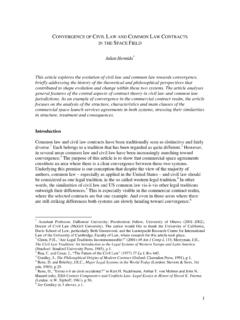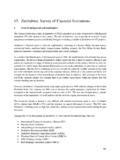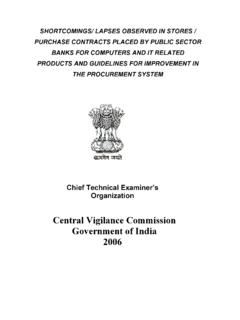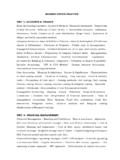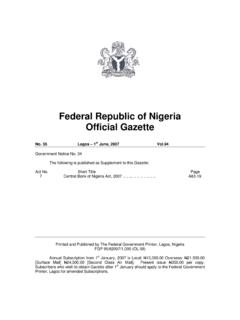Transcription of TEACHING INTERESTS Dr. JULIAN HERMIDA
1 0 TEACHING INTERESTS Dr. JULIAN HERMIDA Prepared for: March, 2007 1 TABLE OF CONTENTS INTRODUCTION 2 TEACHING INTERESTS 3 GROUP A-COURSES 4 GROUP B-COURSES 4 GROUP C-COURSES 4 COURSE OUTLINES 6 COURSE OUTLINE DRAFTS 7 GROUP A COURSE OUTLINES 8 GROUP B COURSE OUTLINES 44 GROUP C COURSE OUTLINES 54 2 INTRODUCTION The sole purpose of this dossier is to form the basis for a discussion on my TEACHING INTERESTS .
2 This dossier starts with a list of the courses I would very much like to teach. I divided my preferred courses into three categories according to my likes, experience, and current Department availability. Then, I have prepared some draft course outlines for representative courses in each group. These are just drafts, works in progress, which I prepared for this discussion. If selected to teach at Algoma University College, I would use these drafts to discuss them with the Dean, Chair, and colleagues. I would then revise them and refine them according to the actual needs and academic culture of the Department. 3 TEACHING INTERESTS My TEACHING INTERESTS include a wide array of Law, socio-legal, and Politics courses, which I would like and am ready- to teach.
3 I have divided my preferred courses into three categories. Group A includes courses on Canadian Law and Jurisprudence, Group B includes courses on International Law and Aboriginal Law, and Group C includes courses on Legal theory, Legal history, Alternative Dispute Resolution, and Law and Politics. I am truly passionate about all these courses. Besides, I have been TEACHING them for a few years, either as stand-alone courses or as a substantial part of other more general courses. Additionally, I have direct research and/or professional experience in most of the topics covered by these courses. Please note that, above all, I am a team player, and I would never mind refraining from TEACHING a course I like to let another colleague teach it.
4 Neither would I mind TEACHING a course other colleagues do not want or cannot teach. 4 GROUP A: Canadian Law and Jurisprudence courses 9 JURI 1105 E Introduction to Legal Studies 9 JURI 2106 E Introduction to Private Law 9 JURI 2107 E Introduction to Public Law 9 JURI 2306 E Commercial Law 9 JURI 3206 E Introduction to Criminal Law and Procedure 9 JURI 3306 E Legal Rights in Criminal Proceedings 9 JURI 3506 E - Legal Regulation of Close Adult Relationships 9 JURI 4236 E - Youth in Conflict with the Law 9 JURI 4246 E - Women in Conflict with the Law GROUP B: International Law and Aboriginal Law courses 9 International Law 9 International Human Rights Law 9 International Criminal Law and Justice 9 Comparative Law 9 Aboriginal Law 5 GROUP C.
5 Legal Theory courses 9 Legal Theory 9 Legal History 9 JURI 2136 E Introduction to Interpersonal Dispute Resolution 9 JURI 2126 E and JURI 4126 E - Legal Reasoning 9 JURI 3706 E - Rights and Law 9 JURI 4486 E - Legal Professions 9 Law and Politics 6 COURSE OUTLINES 7 COURSE OUTLINE DRAFTS The following course outlines are intended for discussion only. Except for the first course outline, all syllabi include only the description of the course, objectives, class schedules, textbooks, and other resources. Parts that are generally constant in all outlines, such as premises, coordinates, methodology, grading system, plagiarism policy, and student with disabilities policy, among others, have been omitted for ease of reading.
6 While not constant, evaluation and evaluation criteria have also been omitted in the rest of the course syllabi to facilitate the reading of this dossier. I am available to discuss these issues in depth for any course. 8 GROUP A COURSE OUTLINES 9 INTRODUCTION TO LEGAL STUDIES Prof.: Dr. JULIAN HERMIDA Course number: JURI 1105 E COURSE DESCRIPTION This course is designed as a general examination of law and the Canadian legal system. It provides a basic understanding of the role and function of law and the legal system in Canadian society. The course explores the various branches of law, the common law, civil law, and aboriginal traditions present in Canada, as well as rules for statutory interpretation, the role of precedent, and the role of judges, lawyers and lay persons in the Canadian justice system.
7 It also examines legal reasoning and legal methods. This course provides a general understanding of legal issues and problems, as well as a sound basis for further study in the area of law and justice. PREMISES CONCEPT OF KNOWLEDGE AND LEARNING Knowledge is a constantly evolving process, which can be produced personally and collectively. From an individual perspective, knowledge is personal, socially and historically contextualized, and dependent on psychological variables. From the class perspective, knowledge is a collective production, where all participants can make their contribution. In the process of producing knowledge, there is a dialectic relationship between action and reflection, where one feeds the other and vice versa.
8 Successful learning is based on a personal involvement of students in their own learning. The learning environment, including the TEACHING methods, the teacher s attitude, and the class atmosphere, among other factors, is determinative of the students approach to learning, as well as, the learning outcomes. The role of the teacher is that of a facilitator and tutor rather than a lecturer. 10 Student peers are a powerful source of learning. Evaluation is conceived mainly as formative. OBJECTIVES This course is conceived so that students can: 1. Understand the role and function of law. a. Reconsider the role of formal legal regulation in relation to civil society.
9 2. Recognize and understand the principal branches of law in the Canadian legal system. a. Appreciate and employ the formal language and discourse of socio-legal studies. 3. Appreciate the co-existence and development of the three legal traditions in Canada. a. Understand the evolution of common law and civil law in Canada. b. Understand the evolution of aboriginal law in Canada. c. Appreciate the co-existence, tensions, and convergence of common law, civil law, and aboriginal law in Canada. 4. Understand and critically value the legal methods and legal reasoning. a. Understand the rules for statutory interpretation and the role of precedent.
10 B. Critically evaluate the legal reasoning and legal methods. c. Be aware of the flaws of the legal method. 5. Critically evaluate the role of judges, lawyers, and lay persons in the Canadian justice system. a. Be aware of the influence of race, ethnicity, gender, immigration status, and social class on the outcome of justice institutions. b. Demonstrate an understanding of how contemporary justice institutions operate. 11 TEACHING OBJECTIVE Deploy a range of advanced transferable skills, such as, oral and written communication skills, the accurate exposition of complex arguments and sets of research findings and the critical evaluation of competing explanations or complex arguments relating to some culturally sensitive topics.

